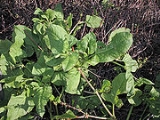
Emex spinosa
Encyclopedia
Emex spinosa, commonly known as lesser jack, is an annual herbaceous plant of the Polygonaceae
. It originates in the warmer parts of the old world
, but now has spread with man to other places. It is common in disturbed areas, aspecially in sandy soils. It has shown some weedy behaviour in restricted areas within southern Australia
.
The plant produces many seeds with a hard, prickly casing. These are produced both in clusters along the branches and at the base of the stem. The root is thick and succulent. At the end of the plant's life, the root dries up and pulls the seeds at the base of the stem into the ground.
The spiny, durable seeds make the plant a nuisance around human habitats, much like the similarly shaped seeds of Tribulus terrestris
.
Polygonaceae
Polygonaceae is a family of flowering plants known informally as the "knotweed family" or "smartweed family"— "buckwheat family" in the United States. The name is based on the genus Polygonum and was first used by Antoine Laurent de Jussieu in 1789 in his book, Genera Plantarum. The name refers...
. It originates in the warmer parts of the old world
Old World
The Old World consists of those parts of the world known to classical antiquity and the European Middle Ages. It is used in the context of, and contrast with, the "New World" ....
, but now has spread with man to other places. It is common in disturbed areas, aspecially in sandy soils. It has shown some weedy behaviour in restricted areas within southern Australia
Australia
Australia , officially the Commonwealth of Australia, is a country in the Southern Hemisphere comprising the mainland of the Australian continent, the island of Tasmania, and numerous smaller islands in the Indian and Pacific Oceans. It is the world's sixth-largest country by total area...
.
Description
The lesser jack tends to grow as a sprawling weed. The leaves are plain in shape, resembling spinach. The flowers of different sexes are clustered separately on the same plant.The plant produces many seeds with a hard, prickly casing. These are produced both in clusters along the branches and at the base of the stem. The root is thick and succulent. At the end of the plant's life, the root dries up and pulls the seeds at the base of the stem into the ground.
The spiny, durable seeds make the plant a nuisance around human habitats, much like the similarly shaped seeds of Tribulus terrestris
Tribulus terrestris
Tribulus terrestris is a flowering plant in the family Zygophyllaceae, native to warm temperate and tropical regions of the Old World in southern Europe, southern Asia, throughout Africa, and Australia. It can thrive even in desert climates and poor soil...
.

